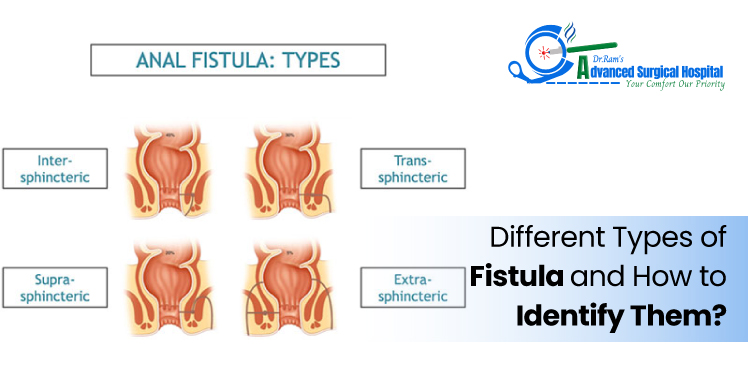Different Types of Fistula and How to Identify Them

When you think of the word fistula, what do you imagine? For the vast majority of us, it sounds like a scary, rare medical issue. But the reality is, fistulas are more common than we might realise, and they can occur in different areas of the body. If you are going through it and looking for Fistula Treatment in Ahmedabadthen you should visit Dr. Ram's Advanced Surgical Hospital for the best results.
A fistula is an abnormal connection between two organs, vessels or tissues that shouldn’t be connected at all. (Where it forms will determine a host of other, and very different, symptoms, from digestive issues to urinary problems to even breathing trouble.)
So, let’s do a deep dive and identify the different types of fistula and how to recognise them simply.
1. Anal Fistula
This is a fistula that occurs most commonly. It typically occurs when an infection in the area around the anus doesn’t heal properly and creates a little tunnel between the anal canal and the skin. Those with recurrent abscesses around the anus are particularly at risk. Left alone, he can become uncomfortable and develop recurrent infections.
How to identify it :
- - Pain or swelling in the area around the anus that does not go away
- - Discharge or pus that recurs
- - Irritation or sores that develop on the anus when passing stool
- - There is discharge around the outside of the anus that smells bad
2. Arteriovenous Fistula
An arteriovenous (AV) fistula occurs when an artery and a vein join directly, without the tiny capillaries between them. Though doctors can surgically fashion them for people who need dialysis, they can also develop on their own after injury or in the presence of certain health conditions. Untreated, they can burden the heart and disrupt circulation.
How to identify it :
- - A bulging vein under the skin
- - Swelling in arms or legs
- - Constant tiredness or weakness
- - A whooshing sound or fast pulse in the area over the affected artery (a doctor can hear the sound with a stethoscope)
3. Obstetric Fistula
This kind is uncommon and very dangerous. It develops between the vagina and the bladder or rectum, typically when labour is prolonged or obstructed and when medical help arrives too late. It can cause incontinence, where a woman loses control over her bladder or bowels, and that is a severe problem for a woman’s health and her quality of life. It’s not seen as a better option even though, unfortunately, it is used more in areas that have limited access to maternity care.
How to identify it :
- - Leaking of urine or stool constantly through the vagina
- - Foul odour and frequent infections
- - Severe irritation and discomfort
- - Typically, a result of bad or hard labour
4. Gastrointestinal Fistula
A gastrointestinal fistula links different sections of the intestines, or the intestines to other organs, such as the bladder or even the skin. It tends to occur after abdominal surgery, Crohn’s disease or infections. These fistulas can cause disruptions in the digestion and absorption of nutrients, leading to dehydration and malnourishment.
How to identify it :
- - Drips (drainage of the implanted meal replacement product solution) of digestive juice to the skin
- - Severe diarrhoea or dehydration
- - Constant abdominal pain or infections
- - Malnutrition caused by a lack of absorption of food
5. Rectovaginal Fistula
In this variety, there is an abnormal opening between the rectum and the vagina. This may happen after childbirth injuries, operations or in the presence of an inflammatory bowel disease. It can be very socially embarrassing and has been known to lead to health problems when stool or gas passes through the vagina, as doing so can be very uncomfortable.
How to identify it :
- - Stool or gas coming out of the vagina
- - Frequent vaginal infections
- - Unpleasant odour and irritation
- - Discomfort during intimacy
6. Urinary Tract Fistulas
These are fistulas between the urinary system (bladder or urethra) and the vagina. They tend to occur after surgeries such as hysterectomy, pelvic radiation or difficult childbirth. As those impact the urinary tract, they do cause chronic incontinence, infections, and lots of pain.
How to identify it :
- - Constant urinary dribbling (urine leakage, even when you urinate normally)
- - Repeated urinary tract infections
- - Vaginal irritation and odour
- - Pain or discomfort while urinating
7. Bronchopleural Fistula
A Bronchopleural fistula is a rare occurrence that develops between the bronchial tubes and the pleural cavity (the area surrounding the lungs). It normally occurs after lung surgery, infections or trauma. Since it directly involves the lungs, it can lead to severe breathing problems and long-term infections if untreated.
How to identify it :
- - Chronic cough with discharge of pus or air
- - Stubborn chest infections. If you've got a chest infection that just won't go away, rest might not be enough.
- - Shortness of breath and discomfort
- - In the hospitalised patient, gas bubbles may be observed in the chest drain tube.
When Should You See a Doctor?
If you see repeated discharge, leakage, swelling, new pain or an unusual passage between body passages, don’t be passive. Fistulas seldom heal themselves; more often than not, they require medical intervention, be it surgery, drainage, or a specialised surgical procedure.
Yes, fistulas can be a complex condition, but catching the signs early means everything. Whether you’re experiencing pain around your anus, some anal leaking, or ongoing infections, a quick trip to an expert doctor like Dr. Kamlesh Ram or a change in diet and hygiene can prevent you from having bigger, more complicated issues down the line.
